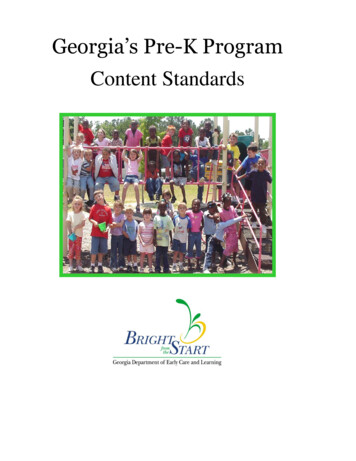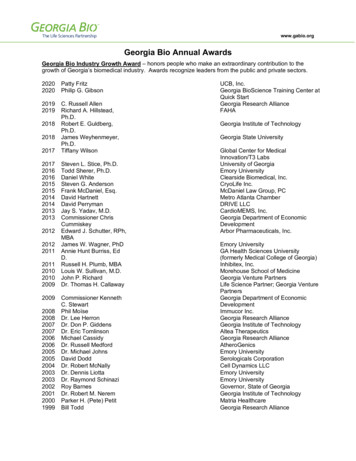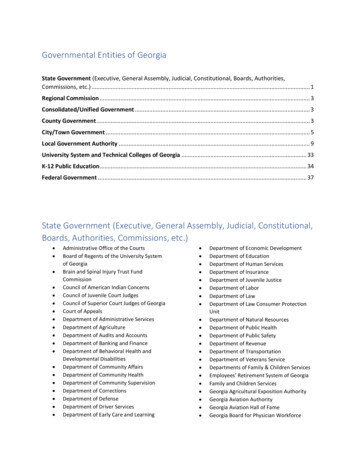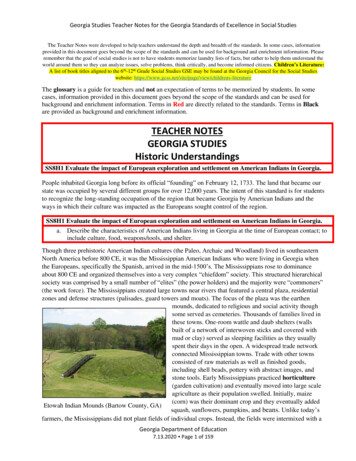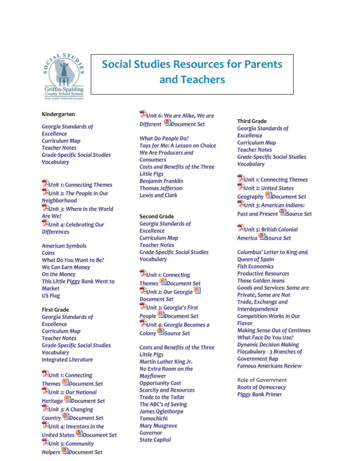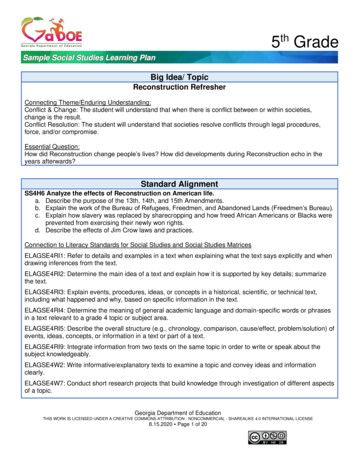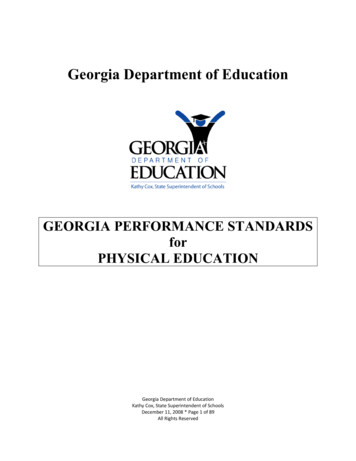
Transcription
Georgia Department of EducationGEORGIA PERFORMANCE STANDARDSforPHYSICAL EDUCATIONGeorgia Department of EducationKathy Cox, State Superintendent of SchoolsDecember 11, 2008 * Page 1 of 89All Rights Reserved
TABLE of CONTENTSSectionPage Number/sI. Acknowledgements3-4Advisory -------------- 3Writing ------------------ 4II. Introduction5-11What are ---------------- 6Benefits of -------------- 6The Georgia Performance Standards------------------------------------- ------------------------------ 10Application of Standards for Students With Disabilities-------------- 10-11Coding System for ---- 11III. Scope and Sequence of Standards12-17IV. Georgia Performance Standards for Physical Education18- ----------------------------- 18-23First ---------------------- 24-29Second ------------------- 30-37Third --------------------- 38-43Fourth ------------------- 44-49Fifth ---------------------- 50-55Sixth ---------------------56-61Seventh Grade -------------62-68Eighth ------------------- 69-75High --------------------- 76-83V. Glossary84-89Georgia Department of EducationKathy Cox, State Superintendent of SchoolsDecember 11, 2008 * Page 2 of 89All Rights Reserved
I.AcknowledgementsPhysical Education Advisory CommitteeNameRepresentingEmily Adams (Cobb County)Grades K-2Jim AnnesiMetro Atlanta YMCAMarlon Baker (Dougherty County) Grades 6-8Shagayla Bullard (Mitchell County) Grades K-2Bill BurnsAmerican Heart AssociationJimmy CallowayGeorgia Coalition for Physical Activity and NutritionSandy DenhamGA Department of Education - School NutritionErin FitzgeraldDepartment of Human Resources Division of Public HealthLinda Galloway (DeKalb County) Grades 6-8Cerie Godfrey (Troup County)Grades 3-5Jacque HarbisonGA Association for Health, PE, Recreation, and DanceMichele Hartzell (Chatham County) Health/PE CoordinatorDr. Lauri JosseyNorth Georgia College & State UniversityChristi KayHealthMpowersDr. Jackie LundGeorgia State UniversityRodney LynPolicy Leadership for Active YouthDenise Magee (Cobb County)Principal – Campbell Middle SchoolCecil Marett (Hart County)Grades 3-5Marcelle MartinGA Department of Education - Virtual SchoolDave Martinez (Cherokee County) Adapted Physical EducationDr. Starla McCollumGeorgia Southern UniversityTherese McGuire (Fulton County) Health/PE CoordinatorDr. Beverly MitchellKennesaw State UniversityDebra Morell (Chatham County)Grades 9-12Stephanye Peek (Cobb County)Grades K-2David Ray (Rockdale County)Loraine Elementary School PrincipalDr. Deborah ShapiroGeorgia State University - Adapted Physical EducationPat Steuck (Jackson County)Principal – East Jackson High SchoolMike Tenoshok (Cobb County)Grades 6-8Kim Thompson (Douglas County) Grades 9-12Jeff Townsend (Cobb County)Grades 9-12Chuck Truett (Gwinnett County)Health/PE CoordinatorShannon Williams (DeKalb County) Health/PE CoordinatorGeorgia Department of EducationKathy Cox, State Superintendent of SchoolsDecember 11, 2008 * Page 3 of 89All Rights Reserved
Physical Education Writing TeamNameRepresentingMary Angela Bryant (Fulton County)Norma Paton-Gibson (DeKalb County)Dana Griffith (Gwinnett County)Stella Irving (Henry County)Laurie Lincoln (Cobb County)Dr. Jackie Lund (Georgia State University)Cindy Marcus (Rockdale County)Cecil Marett (Hart County)Gary McCoy (Fulton County)Deb Morell (Chatham County)Jennifer Jones Powell (DeKalb County)Dave Senecal (Paulding County)Kim Thompson (Douglas County)Jeff Townsend (Cobb County)David Worrall (Cobb County)Joan Wyman (Atlanta Public K-29-129-123-53-5Georgia Department of EducationKathy Cox, State Superintendent of SchoolsDecember 11, 2008 * Page 4 of 89All Rights Reserved
II.IntroductionPhysical Education is an integral part of the total education of every child from kindergartenthrough grade 12. Therefore, every student should have the opportunity to participate in a qualityphysical education program. It is the role of quality physical education programs to help studentsdevelop health-related fitness, physical competence in movement activities, cognitiveunderstanding, and positive attitudes toward physical activity so that they can adopt healthy andphysically active lifestyles. Quality programs are also important because they provide learningexperiences that meet a student’s developmental needs, which in turn helps to improve themental alertness, academic performance, readiness, and enthusiasm for learning.According to the National Association for Sport and Physical Education (NASPE) (1) guidelines,a high-quality physical education program includes the following components: opportunity tolearn, meaningful content, and appropriate instruction.Quality physical education programs should provide the student with the following benefits:Skill development – Develops motor skills that allow for safe, successful, and satisfyingparticipation in physical activities.Regular, healthful physical activity – Provides a wide range of developmentallyappropriate activities for all children and youth. It encourages young people to choose tobe physically active and aware of the benefits.Improved physical fitness – Improves the health-related components of physical fitness(cardiovascular endurance, muscular strength, muscular endurance, flexibility, and bodycomposition).Support of other subject areas – Reinforces knowledge learned in/across the curriculumand serves as a laboratory for application of content in science, math, and social studies,communication skills, and literacy.Self-discipline – Facilitates development of responsibility for personal health, safety, andfitness.Improved judgment – Influences moral development and students assume leadershiproles, cooperate with others, and accept responsibility for their own behavior.Stress reduction – Physical activity becomes an outlet for releasing tension and anxietyand facilitates emotional stability and resilience.Georgia Department of EducationKathy Cox, State Superintendent of SchoolsDecember 11, 2008 * Page 5 of 89All Rights Reserved
Strengthened peer relations – Physical education is a major force in helping children andyouth socialize with others successfully and provides opportunities to learn positive socialskills.Improved self-confidence and self-esteem – Instills a stronger sense of self-worth basedon their mastery of skills and concepts of physical activity. Children become moreconfident, assertive, independent, and self-controlled.Goal setting – Gives children and youth the opportunity to set and strive for personal,achievable goals.Once established, it is difficult to change sedentary habits. Experts agree that childhood is thetime to begin development of active lifestyles, and adolescence is an important time to preventthe decline in physical activity levels. Therefore, it is extremely important to equip young peoplewith the fitness levels, knowledge, motor skills, and personal/social skills they need to be activeboth now and in the future.What are Standards?Standards are statements that define what students should know and be able to do uponcompletion of specific levels of instruction as well as how they will respond to theirenvironment. Standards serve as a guide for excellence and are differentiated from minimumcompetencies or outcomes because they describe the challenging goals for expanding andimproving education.The Benefits of Standards:NASPE has offered a description of the benefits that are derived from having standards forphysical education. NASPE states in its standards document, Moving Into the Future (2004) (1).“A significant benefit to physical education offered through the delineation of acomprehensive set of standards and accompanying assessments is that they combat theuninformed idea that physical education is an “academically soft” area of study. Thestandards essentially say that physical education has academic standing. They say there issuch a thing as achievement, that knowledge and skills matter, and that mere willingparticipation is not the same as education”.How are Standards to be Used?The purpose of developing these standards at the state level is to better serve schools and thelocal community in the process of curriculum development. Curriculum development is a localissue and may differ from school to school while the standards remain the same for all schools inthe state.Georgia Department of EducationKathy Cox, State Superintendent of SchoolsDecember 11, 2008 * Page 6 of 89All Rights Reserved
The Georgia Performance Standards:The Georgia Performance Standards for Physical Education are based on the National PhysicalEducation Standards developed by the National Association for Sport and Physical Education(NASPE). The Standards reflect what a physically educated student should know and be able todo at each grade level (K-12). Six standards with accompanying elements are provided for eachgrade level. The elements are provided to further define the knowledge, skills, and behaviors thatare expected of students at the end of various grade levels. Examples are provided for eachelement and can serve as guidelines for assessing student performance. Rather than definingcurriculum, these standards provide guidance for teachers and are useful in designing appropriatephysical education curricula. A sequential, developmentally appropriate curriculum should bedesigned and implemented to help students acquire the knowledge, skills, attitudes, andconfidence needed to adopt and maintain a physically active and healthy lifestyle.The purpose of this document is to establish content standards for the physical education schoolprogram that clearly identifies consensus statements related to what a student should know, beable to, and how the student should act as a result of a quality physical education program. Inaddition, the standards demonstrate that physical education has meaningful, significant contentand measurable outcomes.A general description of the Standards includes the following:Standard 1: Demonstrates competency in motor skills and movement patterns needed toperform a variety of physical activities.The intent of this standard is development of the physical skills needed to enjoy participation inphysical activities. Mastering movement fundamentals establishes a foundation to facilitatecontinued motor skill acquisition and gives students the capacity for successful and advancedlevels of performance to further the likelihood of participation on a daily basis. In the primaryyears, students develop maturity and versatility in the use of fundamental motor skills (e.g.,running, skipping, throwing, striking) that are further refined, combined, and varied during themiddle school years. These motor skills, now having evolved into specialized skills (e.g., aspecific dance step, chest pass, catching with a glove, or the use of a specific tactic), are used inan increasingly complex movement environment through the middle school years. On the basisof interest and ability, high school students select a few activities for regular participation withinwhich more advanced skills are mastered. In preparation for adulthood, students acquire theskills to participate in a wide variety of leisure and physical activities.Standard 2: Demonstrates understanding of movement concepts, principles, strategies, andtactics as they apply to the learning and performance of physical activities.The intent of this standard is facilitation of learners’ abilities to use cognitive information tounderstand and enhance motor skill acquisition and performance. It enhances the ability to usethe mind to control or direct one’s performance. This includes the application of concepts fromGeorgia Department of EducationKathy Cox, State Superintendent of SchoolsDecember 11, 2008 * Page 7 of 89All Rights Reserved
disciplines such as motor learning and development, sport psychology and sociology, andbiomechanics and exercise physiology. It includes, for example, increasing force productionthrough the summation of forces (e.g. hitting a baseball, lifting a heavy object), knowing theeffects of anxiety on performance (e.g. impact of relaxation techniques), and understanding theprinciple of specificity of training (e.g. you don’t have a person swimming if you want them tobecome a golfer). Knowledge of these concepts and principles and of how to apply themenhances the likelihood of independent learning and therefore, more regular and effectiveparticipation in physical activity. In the lower elementary grades, emphasis is placed onestablishing a movement vocabulary and applying introductory concepts. Through the upperelementary and middle school years, an emphasis is placed on applying and generalizing theseconcepts to real-life physical activity situations. In high school, emphasis is placed on studentsindependently and routinely using a wide variety of increasingly complex concepts. Bygraduation, the student has developed knowledge and ability to independently use his/herknowledge to acquire new skills while continuing to refine and improve existing ones.Standard 3: Participates regularly in physical activity.The intent of this standard is establishment of patterns of regular participation in meaningfulphysical activity. This standard connects what is done in the physical education class with thelives of students outside of the classroom. Although participation within the physical educationclass is important, what the student does outside the class is critical to developing an active,healthy lifestyle that has potential to help prevent a variety of health related problems amongadults. Students make use of the skills and knowledge learned in physical education class as theyengage in regular physical activity outside of the class. They demonstrate effective selfmanagement skills that enable them to participate in physical activity on a regular basis.Voluntary participation often develops from the initial enjoyment that is derived from theactivity coupled with the requisite skills needed for participation. As students develop anawareness of the relationships between activity and its immediate and identifiable effects on thebody, regular participation in physical activity enhances the physical and psychological health ofthe body, social opportunities and relationships, and quality of life. Students are more likely toparticipate if they have opportunities to develop interests that are personally meaningful to them.Young children learn to enjoy physical activity, yet they also learn that a certain level of personalcommitment and earnest work is required to reap the benefits from their participation. Theypartake in developmentally appropriate activities that help them develop movement competenceand should be encouraged to participate in moderate to vigorous physical activity andunstructured play. As students get older, the structure of activity tends to increase and theopportunities for participation in different types of activity increases outside of the physicaleducation class. Attainment of this standard encourages participation commensurate withcontemporary recommendations regarding the type of activity as well as the frequency, duration,and intensity of participation believed to support and sustain good health.Georgia Department of EducationKathy Cox, State Superintendent of SchoolsDecember 11, 2008 * Page 8 of 89All Rights Reserved
Standard 4: Achieves and maintains a health-enhancing level of physical fitness.The intent of this standard is development of students’ knowledge, skills, and willingness toaccept responsibility for personal fitness, leading to an active, healthy lifestyle. Students develophigher levels of basic fitness and physical competence as needed for many work situations andactive leisure participation. Health-related fitness components include cardiorespiratoryendurance, muscular strength and endurance, flexibility, and body composition. Expectations forimproving students’ fitness levels should be established on a personal basis, taking into accountvariation in entry levels and the long-term goal of achieving health-related levels of fitness basedon criterion-referenced standards. Students progress in their ability to participate in moderate tovigorous physical activities that address each component of health-related fitness. Moreover,students become more skilled in their ability to plan, perform, and monitor physical activitiesappropriate for developing physical fitness. Middle school students gradually acquire a greaterunderstanding of the fitness components, the ways in which each component is developed andmaintained, and the importance of each component in overall fitness. Secondary students areable to design and implement an appropriate personal fitness program that enables them toachieve health-related levels of fitness.Standard 5: Exhibits responsible personal and social behavior that respects self and othersin physical activity settings.The intent of this standard is achievement of self-initiated behaviors that promote personal andgroup success in activity settings. These include safe practices, adherence to rules andprocedures, etiquette, cooperation and teamwork, ethical behavior, and positive socialinteraction. Key to this standard is developing respect for individual similarities and differencesthrough positive interaction among participants in physical activity. Similarities and differencesinclude characteristics of culture, ethnicity, motor performance, disabilities, physicalcharacteristics (e.g., strength, size, shape), gender, age, race, and socioeconomic status.Achievement of this standard in the lower elementary grades begins with recognition ofclassroom rules, procedures, and safety. In the upper elementary levels, children learn to workindependently, with a partner, and in small groups. Throughout elementary school, studentsbegin to recognize individual similarities and differences and participate cooperatively inphysical activity. In middle school, adolescents identify the purpose of rules and procedures andbecome involved in decision-making processes to establish the rules and procedures that guidespecific activity situations. They participate cooperatively in physical activity with persons ofdiverse characteristics and backgrounds. High school students initiate responsible behavior,function independently and responsibly, and positively influence the behavior of others inphysical activity settings. They participate with all people, avoid and resolve conflicts, recognizeGeorgia Department of EducationKathy Cox, State Superintendent of SchoolsDecember 11, 2008 * Page 9 of 89All Rights Reserved
the value of diversity in physical activity, and develop strategies for inclusion of others. Highschool students begin to understand how adult work and family roles and responsibilities affecttheir decisions about physical activity and how physical activity, preferences, and opportunitieschange over time.Standard 6: Values physical activity for health, enjoyment, challenge, self-expression,and/or social interaction.The intent of this standard is development of an awareness of the intrinsic values and benefits ofhow participation in physical activity provides personal meaning. Physical activity providesopportunities for self-expression and social interaction and can be enjoyable, challenging, andfun. These benefits develop self-confidence and promote a positive self-image; thereby, enticingpeople to continue participation in physical activity throughout their lifespan. Elementarychildren derive pleasure from movement sensations and experience challenge and joy as theysense a growing competence in movement ability. At the middle school level, participation inphysical activity provides important opportunities for challenge, social interaction, and groupmembership, as well as opportunities for continued personal growth in physical skills and theirapplied settings. Participation at the high school level continues to provide enjoyment andchallenge, as well as opportunities for self-expression and social interaction. As a result of theseintrinsic benefits of participation, students begin to actively pursue life-long physical activitiesthat meet their own needs.Assessment:The standards are considered to be consensus statements about what a student should know andbe able to do, and how they will act. They not only provide a basis for developing physicaleducation programs at the national, state, and local levels, but also provide a basis for studentassessment. Assessment is the process of gathering evidence about a student’s level ofachievement in a specified subject area and of making inferences based on that evidence for avariety of purposes. The primary goal of assessment should be seen as the enhancement oflearning, rather than simply the documentation of learning and assigning a grade. Whereas abroad range of assessment techniques could well be used to determine whether a given standardis being met, assessment should (1) reflect the subject content that is most important for studentsto learn, (2) enhance learning through a connection with instruction, (3) provide reliableevidence of student performance, and (4) yield valid inferences about student learning. Theinstruction and assessment process should be dynamic and continuous, yielding informationabout student progress toward the achievement of the content standards in physical education.Application of Physical Education Performance Standards for Students with Disabilities:The necessity of assuring that physical education services are provided to students withdisabilities is in the implementing regulations of the Individuals with Disabilities Education ActGeorgia Department of EducationKathy Cox, State Superintendent of SchoolsDecember 11, 2008 * Page 10 of 89All Rights Reserved
(IDEA). The IDEA requires that each child with a disability be afforded the opportunity toparticipate in the regular physical education program available to nondisabled children withspecifically designed instruction (adapting, as appropriate, to the needs of the child, the content,methodology, or delivery of instruction) to address the unique needs of the child. Removal ofchildren with disabilities from the general physical education environment occurs only if thenature or severity of the disability is such that education in the regular classes with the use ofsupplementary aids and services cannot be achieved satisfactorily. At this point, special physicaleducation services and programming may be used as an appropriate alternative. Some of theelements supporting the Standards may not be developmentally or functionally appropriate forevery child with a disability unless accommodations or modifications are implemented. Physicaleducators must be committed and prepared to make appropriate adjustments in the curriculum tomeet the unique needs of the learner. Making appropriate modifications to the curriculum tomeet individual needs allows for meaningful and relevant experiences provided in a safe andsecure environment.1. National Association for Sport and Physical Education (2004). Moving into the Future:National Standards for Physical Education (2nd ed.). Reston, VA: Author.Coding System for Standards:See below for an explanation and example of the coding system utilized to identify each gradelevel standard.Example 1:PEK.1PEPhysical EducationKKindergarten1Standard 1Example 2:PE3.2PEPhysical Education3Grade 32Standard 2Example 3:PEHS.6PEPhysical EducationHSHigh School6Standard 6Georgia Department of EducationKathy Cox, State Superintendent of SchoolsDecember 11, 2008 * Page 11 of 89All Rights Reserved
III.Scope and SequenceStandard 1: Demonstrates competency in motor skills and patterns needed to perform a variety of activities.KindergartenFirst GradeSecond GradeThird GradeFourth GradeFifth GradeSixth GradeSeventh GradeEighth GradeHigh schoolLocomotor movement patterns (e.g. hop, jump, leap) and demonstrates mature patterns whenwalking and running. A variety of movement skills to use nonlocomotor skills (e.g. bend, twist,turn) while moving and stationary. Weight transfer and balance activities are important inlearning to move in relation to others while moving through personal and general space.Low level of challenge when performing locomotor skills (e.g. dance, game, or combination withnon-locomotor skills) demonstrating mature form in the hop, jump, and leap. When movingthrough personal and general space, demonstrates the ability to move in a variety of pathways, indifferent directions, and at different levels. Several nonlocomotor skills are done in a sequence orin conjunction with locomotor or manipulative skills. Demonstrates ability to direct manipulativeobjects toward an intended target.Mature form in skipping, sliding and galloping when moving through personal and general space.Ability to change directions on teacher command or adapt movement in relation to a partner isexpected. Combine non-locomotor movements with manipulative and locomotor patterns in avariety of games and dances. Ability to demonstrate momentary body control during balance andweight transfer is evident. Demonstrates mastery of underhand throwing patterns whenperforming manipulative skills. Ability to catch an object at a medium level of trajectory isdemonstrated in a closed environment (not during game play). Underhand striking skills are beingperformed but are not at a mature level.Mature form in all locomotor and non-locomotor movement patterns while participating in smallsided games, body control (e.g. gymnastics, inline skating and rhythmic activities (e.g. structureddance, jump rope, creative dance). Ability to perform variations of different locomotor skills (e.g.jumping for height and distance; skipping at different speeds). By the end of third grade, studentswill be able to demonstrate all striking and throwing patterns. Students can catch a moving objectfrom a high trajectory in nongame play environments and are able to catch objects at a mediumlevel trajectory during game play.Ability to combine skills in dynamic and complex situations, demonstrating sequences commonlyassociated with various sports and activities (e.g. moving to a ball, trapping, dribbling, and thenpassing it; forward roll, scale (balance), travel and then do a cartwheel). Overhead throwing andstriking patterns are mastered and ability to catch or handle objects from and trajectory (low,medium, or high) in simple situations. Ability to move in tempo to slow and fast rhythms.Move through space using any movement pattern in combination with any non-motor skill incomplex environments. Movement patterns are demonstrated with consistency and with goodform. Some specialized skills, like those associated with sports are refined & used in game play.Ability to hit targets when performing manipulative skills. Ability to combine movement inmeaningful ways, creating movement sequences that are smooth and fluid & done to severaldifferent rhythmic patterns.Motor skills are combined and used in specific game and performance situations. Refine and varyskills learned in elementary years using them to participate in small-sided games, dance, orindividual activities.Complex combinations of movement specific to game, sport, rhythms, and/or physical activitysettings. Specialized skills are adapted to meet the requirements of increasingly complexstrategies.Demonstrate the ability to use mature forms for the basic skills and tactics in six of eightcategories.Grades 9-12 will demonstrate the ability to participate in a variety of invasion, net wall, or fieldgame; target, dance/rhythm, or outdoor activity; fitness or individual activity.Georgia Department of EducationKathy Cox, State Superintendent of SchoolsDecember 11, 2008 * Page 12 of 89All Rights Reserved
Standard 2: Demonstrates understanding of movement concepts, principles, strategies, and tactics asthey apply to the learning and performance of physical activities.KindergartenFirst GradeSecond GradeThird GradeFourth GradeFifth GradeSixth GradeSeventh GradeEighth GradeHigh schoolStudents develop movement vocabulary and use terms appropriately. Students use movement andmanipulative skill concepts when applicable.Students continue to use movement and manipulative skill concepts while expanding and applyingskills to their base knowledge.Students apply multiple movement concepts while using manipulatives.Students use performance feedback to increase their cognitive understanding of a skill as well asimprove performance.Students begin to apply basic concepts of movement to improve their individual performance.They can identify elements of form or motor development principles to improve performance ofothers.Students will perform complex motor skills and be able to transfer concepts learned in otherskills/games for performance of the new skill/game. They self-analyze their own skills as well astheir classmates and discuss methods for improving performance.Students can identify principles of practice and conditioning that enhance movement performance.They have higher levels of understanding and movement sk
(cardiovascular endurance, muscular strength, muscular endurance, flexibility, and body composition). Support of other subject areas - Reinforces knowledge learned in/across the curriculum and serves as a laboratory for application of content in science, math, and social studies, communication skills, and literacy.

